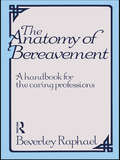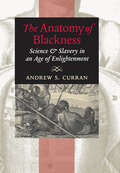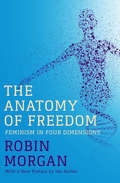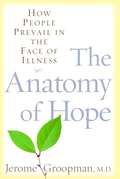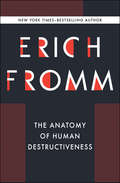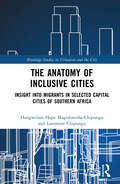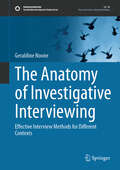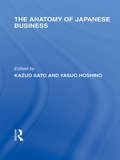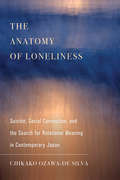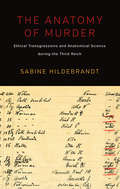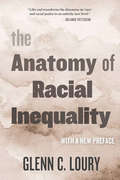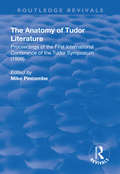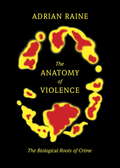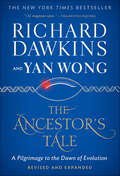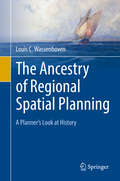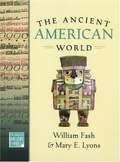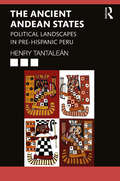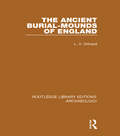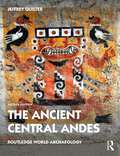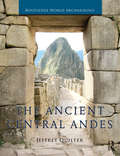- Table View
- List View
The Anasazi: The Ancient Builders
by Scott ForesmanThe Anasazi: The Ancient Builders, Reading 2011 English Language Learner Reader
The Anatomy of Bereavement: A Handbook for the Caring Professions (The\caring Professions Ser.)
by Beverley RaphaelFirst published in 1985. Routledge is an imprint of Taylor & Francis, an informa company.
The Anatomy of Blackness: Science and Slavery in an Age of Enlightenment
by Andrew S. Curran2012 Outstanding Academic Title, Choice MagazineThis volume examines the Enlightenment-era textualization of the Black African in European thought. Andrew S. Curran rewrites the history of blackness by replicating the practices of eighteenth-century readers. Surveying French and European travelogues, natural histories, works of anatomy, pro- and anti-slavery tracts, philosophical treatises, and literary texts, Curran shows how naturalists and philosophes drew from travel literature to discuss the perceived problem of human blackness within the nascent human sciences, describes how a number of now-forgotten anatomists revolutionized the era’s understanding of black Africans, and charts the shift of the slavery debate from the moral, mercantile, and theological realms toward that of the "black body" itself. In tracing this evolution, he shows how blackness changed from a mere descriptor in earlier periods into a thing to be measured, dissected, handled, and often brutalized. Penetrating and comprehensive, The Anatomy of Blackness shows that, far from being a monolithic idea, eighteenth-century Africanist discourse emerged out of a vigorous, varied dialogue that involved missionaries, slavers, colonists, naturalists, anatomists, philosophers, and Africans themselves.
The Anatomy of Freedom
by Robin MorganThe classic of feminist vision by one of its greatest writers, with a new preface by the author With the advent of Einstein's Theory of Relativity, physics and our world changed forever. In The Anatomy of Freedom, Robin Morgan shows us how the empowerment of women--half of humanity--will have the same transformative power for society that e=mc2 had for the physical world. This is not simply another feminist treatise. Morgan looks beyond the women's movement as a crucial struggle for equal rights; she sees this process as the fundamental motor for freeing both women and men, and as a necessity for the survival of sentient life and of the planet itself. She explains and demystifies theoretical physics in accessible terms and, astonishingly, uses it as a prism through which to view the equation of relationships and gender, while going deep into the subconscious and plumbing the roots of passion. At the same time, she makes vital connections between these internal realities and global issues of the environment, economics, and family. There has perhaps never been a book more daring. The Anatomy of Freedom shows a master at her peak.
The Anatomy of Hope: How People Prevail in the Face of Illness
by Jerome GroopmanWhy do some people find and sustain hope during difficult circumstances, while others do not? What can we learn from those who do, and how is their example applicable to our own lives?The Anatomy of Hope is a journey of inspiring discovery, spanning some thirty years of Dr. Jerome Groopmans practice, during which he encountered many extraordinary people and sought to answer these questions. This profound exploration begins when Groopman was a medical student, ignorant of the vital role of hope in patients lives and it culminates in his remarkable quest to delineate a biology of hope. With appreciation for the human elements and the science, Groopman explains how to distinguish true hope from false hope and how to gain an honest understanding of the reach and limits of this essential emotion.
The Anatomy of Human Destructiveness: Escape From Freedom, To Have Or To Be?, And The Anatomy Of Human Destructiveness (Pelican Ser.)
by Erich FrommA study of aggression from the renowned social psychologist and New York Times–bestselling author of The Art of Loving and Escape from Freedom. Throughout history, humans have shown an incredible talent for destruction as well as creation. Aggression has driven us to great heights and brutal lows. In The Anatomy of Human Destructiveness, renowned social psychologist Erich Fromm discusses the differences between forms of aggression typical for animals and two very specific forms of destructiveness that can only be found in human beings: sadism and necrophilic destructiveness. His case studies span zoo animals, necrophiliacs, and the psychobiographies of notorious figures such as Adolf Hitler and Joseph Stalin. Through his broad scholarship, Fromm offers a comprehensive exploration of the human impulse for violence. This ebook features an illustrated biography of Erich Fromm including rare images and never-before-seen documents from the author&’s estate.
The Anatomy of Inclusive Cities: Insight into Migrants in Selected Capital Cities of Southern Africa (Routledge Studies in Urbanism and the City)
by Lovemore Chipungu Hangwelani Hope Magidimisha-ChipunguCreating cities inclusive of immigrants in Southern Africa is both a balancing act and a protracted process that requires positive attitudes informed by accommodative institutional frameworks. This book revolves around two key contemporary issues that cities around the globe are trying to achieve – viz. the need to build inclusive cities and the need to accommodate immigrants. The search for building inclusive cities is an on-going challenge which most cities are grappling with. This challenge is complicated by the need to include immigrants who are always side-lined by policies of host countries. This book discusses the host–immigrant interface by providing a detailed insight of anchors of inclusive cities and a holistic picture of who immigrants are. These are then discussed contextually within the Southern African region, where insight into selected cities is provided to some depth using empirical evidence. The discussion on inclusive cities and immigrants is a universal narrative targeting practitioners and students in town and regional planning, urban studies, urban politics, migration and international relations. The Southern African region once more provides an opportunity to further interrogate and understand the dynamics of immigration in selected cities. This book will also be of interest to policy makers dealing with challenges of inclusivity in the light of immigrants.
The Anatomy of Investigative Interviewing: Effective Interview Methods for Different Contexts (Sustainable Development Goals Series)
by Geraldine NooneThis book draws on international research and best practices to provide readers with the knowledge and insights necessary to navigate the complex and challenging environment of investigative interviewing. It highlights the importance of investigative interviewing in investigations, and provides guidance on how to conduct effective and ethical interviews in five critical investigative contexts, including: · Regulatory, Corporate and workplace investigations · Corruption investigations and interviewing &“Whistleblowers&” · Forensic interviewing of children · Sexual and gender-based violence This volume features case studies and excerpts from real-life interviews to create evidence-based tools for conducting effective, ethical interviews. The effectiveness of the interview techniques described are demonstrated in a wide range of investigative contexts. Ultimately, this book aims to increase the likelihood that victims of abuse, exploitation, trafficking and violence have a voice in the justice system and reduce the risk of secondary victimization. It is ideal for criminal justice practitioners and those interested in fulfilling the UN's Sustainable Development Goal #16, &“Promote peaceful and inclusive societies for sustainable development, provide access to justice for all and build effective, accountable and inclusive institutions at all levels".
The Anatomy of Japanese Business (Routledge Library Editions: Japan)
by Kazuo SatoThis volume collects eleven essays written by Japanese experts on various aspects of Japanese business management and is a sequel to the volume Industry and Business in Japan. It examines the mechanisms for Japan’s phenomenal economic growth since the Second World War by analyzing Japanese management, business groups, production systems and business strategy.
The Anatomy of Loneliness: Suicide, Social Connection, and the Search for Relational Meaning in Contemporary Japan (Ethnographic Studies in Subjectivity #14)
by Chikako Ozawa-de SilvaLoneliness is everybody’s business. Neither a pathology nor a rare affliction, it is part of the human condition. Severe and chronic loneliness, however, is a threat to individual and public health and appears to be on the rise. In this illuminating book, anthropologist Chikako Ozawa-de Silva examines loneliness in Japan, focusing on rising rates of suicide, the commodification of intimacy, and problems impacting youth. Moving from interviews with college students, to stories of isolation following the 2011 natural and nuclear disasters, to online discussions in suicide website chat rooms, Ozawa-de Silva points to how society itself can exacerbate experiences of loneliness. A critical work for our world, The Anatomy of Loneliness considers how to turn the tide of the "lonely society" and calls for a deeper understanding of empathy and subjective experience on both individual and systemic levels.
The Anatomy of Murder
by Sabine HildebrandtOf the many medical specializations to transform themselves during the rise of National Socialism, anatomy has received relatively little attention from historians. While politics and racial laws drove many anatomists from the profession, most who remained joined the Nazi party, and some helped to develop the scientific basis for its racialist dogma. As historian and anatomist Sabine Hildebrandt reveals, however, their complicity with the Nazi state went beyond the merely ideological. They progressed through gradual stages of ethical transgression, turning increasingly to victims of the regime for body procurement, as the traditional model of working with bodies of the deceased gave way, in some cases, to a new paradigm of experimentation with the "future dead. "
The Anatomy of National Fantasy: Hawthorne, Utopia, and Everyday Life
by Lauren Gail BerlantCareful appraisal of The Scarlet Letter.
The Anatomy of Racial Inequality: With a New Preface (The\w. E. B. Du Bois Lectures #4)
by Glenn C. Loury“Paints in chilling detail the distance between Martin Luther King’s dream and the reality of present-day America.” —Anthony Walton, Harper’s “Intellectually rigorous and deeply thoughtful…Loury’s book deals with racial stigma…in its political and philosophical aspects as a cause of black disadvantage…An incisive, erudite book by a major thinker.” —Gerald Early, New York Times Book Review “Lifts and transforms the discourse on ‘race’ and racial justice to an entirely new level.” —Orlando Patterson “He is a genuine maverick thinker…The Anatomy of Racial Inequality both epitomizes and explains Loury’s understanding of the depressed conditions of so much of black society today.” —New York Times Magazine “Loury provides an original and highly persuasive account of how the American racial hierarchy is sustained and reproduced over time. And he then demands that we begin the deep structural reforms that will be necessary to stop its continued reproduction.” —Michael Walzer Why are Black Americans so persistently confined to the margins of society? And why do they fail across so many metrics—wages, unemployment, income levels, test scores, incarceration rates, health outcomes? Known for his influential work on the economics of racial inequality and for pioneering the link between racism and social capital, Glenn Loury is not afraid of piercing orthodoxies and coming to controversial conclusions. In this now classic work, he describes how a vicious cycle of tainted social information helped create the racial stereotypes that rationalize and sustain discrimination. Brilliant in its account of how racial classifications are created and perpetuated, and how they resonate through the social, psychological, spiritual, and economic life of the nation, this compelling and passionate book gives us a new way of seeing—and of seeing beyond—the damning categorization of race.
The Anatomy of Tudor Literature: Proceedings of the First International Conference of the Tudor Symposium (1998) (Routledge Revivals)
by Mike PincombeThis title was first published in 2001. Is there such a thing as "Tudor literature"? The question is the theme that binds the essays in this collection. Scholars from around the world address the question of whether there is a sense of continuity in the literature of the Tudor century. The volume begins by looking at early Tudor writers, such as Thomas More, and then moves on to look at Elizabethan poetry and prose, ending by covering the late Tudor dramas, and Shakespeare.
The Anatomy of Violence: The Biological Roots of Crime
by Adrian RaineWith an 8-page full-color insert, and black-and-white illustrations throughoutWhy do some innocent kids grow up to become cold-blooded serial killers? Is bad biology partly to blame? For more than three decades Adrian Raine has been researching the biological roots of violence and establishing neurocriminology, a new field that applies neuroscience techniques to investigate the causes and cures of crime. In The Anatomy of Violence, Raine dissects the criminal mind with a fascinating, readable, and far-reaching scientific journey into the body of evidence that reveals the brain to be a key culprit in crime causation. Raine documents from genetic research that the seeds of sin are sown early in life, giving rise to abnormal physiological functioning that cultivates crime. Drawing on classical case studies of well-known killers in history--including Richard Speck, Ted Kaczynski, and Henry Lee Lucas--Raine illustrates how impairments to brain areas controlling our ability to experience fear, make good decisions, and feel guilt predispose us to violence. He contends that killers can actually be coldhearted: something as simple as a low resting heart rate can give rise to violence. But arguing that biology is not destiny, he also sketches out provocative new biosocial treatment approaches that can change the brain and prevent violence. Finally, Raine tackles the thorny legal and ethical dilemmas posed by his research, visualizing a futuristic brave new world where our increasing ability to identify violent offenders early in life might shape crime-prevention policies, for good and bad. Will we sacrifice our notions of privacy and civil rights to identify children as potential killers in the hopes of helping both offenders and victims? How should we punish individuals with little to no control over their violent behavior? And should parenting require a license? The Anatomy of Violence offers a revolutionary appraisal of our understanding of criminal offending, while also raising provocative questions that challenge our core human values of free will, responsibility, and punishment.
The Anatomy of the Case Study
by Gary Thomas Kevin MyersThis sharp, stimulating title provides a structure for thinking about, analysing and designing case study. It explores the historical, theoretical and practical bones of modern case study research, offering to social scientists a framework for understanding and working with this form of inquiry. Using detailed analysis of examples taken from across the social sciences Thomas and Myers set out, and then work through, an intricate typology of case study design to answer questions such as: How is a case study constructed? What are the required, inherent components of case study? Can a coherent structure be applied to this form of inquiry? The book grounds complex theoretical insights in real world research and includes an extended example that has been annotated line by line to take the reader through each step of understanding and conducting research using case study.
The Anatomy of the Case Study
by Gary Thomas Kevin MyersThis sharp, stimulating title provides a structure for thinking about, analysing and designing case study. It explores the historical, theoretical and practical bones of modern case study research, offering to social scientists a framework for understanding and working with this form of inquiry. Using detailed analysis of examples taken from across the social sciences Thomas and Myers set out, and then work through, an intricate typology of case study design to answer questions such as: How is a case study constructed? What are the required, inherent components of case study? Can a coherent structure be applied to this form of inquiry? The book grounds complex theoretical insights in real world research and includes an extended example that has been annotated line by line to take the reader through each step of understanding and conducting research using case study.
The Ancestor's Tale: A Pilgrimage to the Dawn of Evolution
by Richard Dawkins Yan WongThe renowned biologist and thinker Richard Dawkins presents his most expansive work in this revised edition that offers a comprehensive look at evolution.Loosely based on the form of Chaucer's Canterbury Tales, Dawkins's tale takes us modern humans back through four billion years of life on our planet. As the pilgrimage progresses, we join with other organisms at the forty "rendezvous points" where we find a common ancestor. The band of pilgrims swells into a vast crowd as we join first with other primates, then with other mammals, and so on back to the first primordial organism.Dawkins's brilliant, inventive approach allows us to view the connections between ourselves and all other life in a bracingly novel way. It also lets him shed bright new light on the most compelling aspects of evolutionary history and theory: sexual selection, speciation, convergent evolution, extinction, genetics, plate tectonics, geographical dispersal, and more. The Ancestor's Tale is at once a far-reaching survey of the latest, best thinking on biology and a fascinating history of life on Earth. Here Dawkins shows us how remarkable we are, how astonishing our history, and how intimate our relationship with the rest of the living world.
The Ancestry of Regional Spatial Planning: A Planner’s Look at History
by Louis C. WassenhovenThis book is not a historical or archaeological treatise, but rather a study in which the author looks at the past, not as a historian, but as a planner who has the ambition to unravel the early manifestations of his discipline; a discipline which did not exist as such in remote periods, but the ingredients of which were nevertheless present. The author has observed the past equipped with knowledge and understanding of what regional planning was in the second half of the twentieth century and still is. He stands in the period of the first decades after the Second World War, which were the formative years of regional planning, and looks back at bygone ages. He discusses ideas and literature from the immediate post-war period in order to examine the ancestry of regional planning through their lens. The book will attract a broad range of readers because of its approach and its wide coverage of historical periods and world regions. Although Europe is the main focus, the book contains material on all continents and all periods, the ancient world, the medieval age and the modern era. The history of Urban Planning is taught and researched widely, but the history, or pre-history, before the twentieth century, of Regional Spatial Planning is not. This book will fill that vacuum.
The Ancient American World (The World in Ancient Times #8)
by Mary E. Lyons William Leonard FashA Zapotec village chief named One Earthquake is murdered by his enemies, who then carve the gruesome image of his death on a huge stone slab and place it in their temple as a warning to others. An Inca official selects young village girls to be raised in the distant House of the Chosen Women, where they will spend the rest of their childhoods learning traditional arts in complete seclusion. A Spanish priest named Bernardino Sahagn recounts the development of the mighty Aztec empire in Mesoamerica and witnesses its tragic overthrow by Spanish conquistadors. These are a few of the gripping stories readers will encounter in The Ancient American World. Authors William Fash and Mary E. Lyons use a wide range of primary sources including sculptures, hieroglyphs, pottery, and ancient tombs to trace the captivating history of ancient America. Readers accompany archaeologists as they unearth fantastic artifacts and spectacular buildings and decode ancient manuscripts to unlock the secrets of these cultures. From farming to the building of great pyramids and from sacred sacrifices to the Spanish conquest, The Ancient American World uses archaeological findings and ancient texts to explore the remarkable cultures of this region.
The Ancient Andean States: Political Landscapes in Pre-Hispanic Peru
by Henry TantaleánThe Ancient Andean States combines modern social theory, recent archaeological literature and the experience of the author to examine politics and power in the great Andean prehispanic societies.
The Ancient Burial-mounds of England (Routledge Library Editions: Archaeology)
by L.V. GrinsellFirst published in 1936 and rewritten in 1953, this book embodies the results of the author’s extensive researches and fieldwork. Part one considers types of barrows and dating, their building and the cult of the dead from Palaeolithic to Saxon times. A chapter is dedicated to maps and another to fieldwork in particular, while the final bit of the introductory material discussed barrow-digging from the time of the Romans to the twentieth century. Part two is the regional surveys, from Cornwall to Kent and northwards to the Scottish border.
The Ancient Celtic Festivals: and How We Celebrate Them Today
by Clare Walker Leslie Frank E. GeraceTravel 2,500 years back in time to find out where many of our modern holiday traditions originated. • Charming full-color ink and watercolor illustrations throughout. • This valuable resource for teachers and parents uses hands-on activities, natural science facts, and observations to explore the concepts of measuring time, making calendars, and marking seasonal celebrations. • Shows how our popular holiday traditions are rooted in nature, beginning as the seasonal festivals of an ancient society. Children love holiday celebrations but most don't know why they wear masks on Halloween or watch for the groundhog on February 2. Now they can discover that many of our modern traditions started with the festivals of the ancient Celts. The Celts were farming people, so their festivals marked the important events of the agricultural year. Imbolc, in very early spring, celebrated the birth of new lambs, while Samhain, in late fall, celebrated the end of the growing season and the beginning of winter. If we look at our modern calendar, we'll find Groundhog Day falling where Imbolc did, Halloween where the Celts celebrated Samhain, and a host of other holiday correspondences. That's because descendants of the Celts were among the first Europeans to settle in the New World, bringing their holiday traditions with them. In a world of electric lights and store-bought foods, The Ancient Celtic Festivals can help children make the connections to nature that their ancestors did. Whimsically illustrated activity pages invite them to bake a harvest corn bread, stage a spring festival, or warm up the cold depths of winter with hot spiced cider. Teachers, librarians, parents, and children alike will welcome this book as a fun-filled resource.
The Ancient Central Andes (Routledge World Archaeology)
by Jeffrey QuilterThe Ancient Central Andes presents a general overview of the prehistoric peoples and cultures of the Central Andes, the region now encompassing most of Peru and significant parts of Ecuador, Bolivia, northern Chile, and northwestern Argentina. The book contextualizes past and modern scholarship and provides a balanced view of current research. Two opening chapters present the intellectual, political, and practical background and history of research in the Central Andes and the spatial, temporal, and formal dimensions of the study of its past. Chapters then proceed in chronological order from remote antiquity to the Spanish Conquest. A number of important themes run through the book, including: the tension between those scholars who wish to study Peruvian antiquity on a comparative basis and those who take historicist approaches; the concept of "Lo Andino," commonly used by many specialists that assumes long-term, unchanging patterns of culture some of which are claimed to persist to the present; and culture change related to severe environmental events. Consensus opinions on interpretations are highlighted as are disputes among scholars regarding interpretations of the past. The Ancient Central Andes provides an up-to-date, objective survey of the archaeology of the Central Andes that is much needed. Students and interested readers will benefit greatly from this introduction to a key period in South America’s past.
The Ancient Central Andes (Routledge World Archaeology)
by Jeffrey QuilterThe Ancient Central Andes presents a general overview of the prehistoric peoples and cultures of the Central Andes, the region now encompassing most of Peru and significant parts of Ecuador, Bolivia, northern Chile, and northwestern Argentina. The book contextualizes past and modern scholarship and provides a balanced view of current research. Two opening chapters present the intellectual, political, and practical background and history of research in the Central Andes and the spatial, temporal, and formal dimensions of the study of its past. Chapters then proceed in chronological order from remote antiquity to the Spanish Conquest. A number of important themes run through the book, including: the tension between those scholars who wish to study Peruvian antiquity on a comparative basis and those who take historicist approaches; the concept of "Lo Andino," commonly used by many specialists that assumes long-term, unchanging patterns of culture some of which are claimed to persist to the present; and culture change related to severe environmental events. Consensus opinions on interpretations are highlighted as are disputes among scholars regarding interpretations of the past. The Ancient Central Andes provides an up-to-date, objective survey of the archaeology of the Central Andes that is much needed. Students and interested readers will benefit greatly from this introduction to a key period in South America's past.

